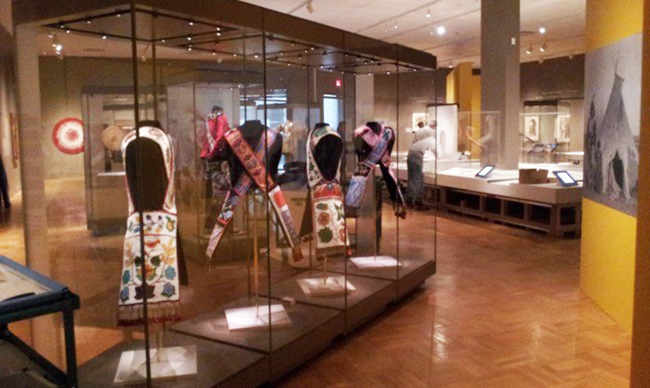Anishinaabeg Art & Power aims to educate

By Laurie LeClair
TORONTO – The Royal Ontario Museum’s long-anticipated show Anishinaabeg Art & Power opened on June 13 with a beautiful reception. Guests sipped cedar and sweet grass tea and helped themselves to appetizers before settling in to listen to the Bear Creek Drummers and speeches of welcome from ROM Director and CEO Josh Bassesches, Co-curator Saul Williams (North Caribou Lake) and New Credit Chief Stacey Laforme. Afterwards people were invited to proceed to the exhibit or stay and listen to the music of Missy Knott and Adam Tario.
Co-Curators Williams, Arni Brownstone (ROM) and Alan Corbiere (M’Chigeeng First Nation) have put together a showcase of Anishinabek creativity and skill as told through primarily Woodland School paintings and beadwork. Items span both geographic and temporal space and visitors can see the same themes and images carried through both dimensions. Adding to these groupings, conceptual pieces are placed throughout the show to illustrate how these themes continue today.
Tradition mixes with current examples of artistry and the logic behind the importance of creative continuum has been successfully applied here. Examples of nineteenth century beadwork sit alongside thought-provoking modern works like Maniwaki’s Nadia Myre’s 2003 beaded Indian Act and Meditations on Red #2. Traditional beaded moccasins and friendship bags find a contemporary counterpart in M’Chigeeng artist Barry Ace’s Dichotomized (2017) and Digital Bandolier (2011). The Woodland School paintings, mostly from the 1970’s through to the 1990’s, share space with representations from ancient petroglyphs and a comparison of the two will find many recurring symbols and themes. Williams’ work is among them, his White Women and their Plants being one of the most beautiful and moving of the collection. Overseeing the entire room words like Nihtam ahkiiwang (Creation), Niimowin (Dancing) Pimi yaawin (Travel) and Wiisagentamowin (Hurt) divide the space into experiential themes. Both male and female artists, some whose names have been lost through time, are represented.
The exhibit is as much about symbols and continuum as it is about the craftsmanship of the items themselves. Brownstone explained, “Most exhibitions have a linear storyline, whereas ours plays out like a musical refrain with neither beginning nor end.” For starters, visitors are able to approach from any direction, walking through concentric circles of displays and although the earliest artifacts can be found at the exhibit’s heart the layout is designed to be timeless. Walking out from the centre guests discover priceless examples of intricate beadwork and other forms of needlecraft purposely chosen from all four directions of Anishinaabeg territory. The number seven, so significant in Anishinabek teachings, recurs throughout: We learn that the ROM has borrowed artifacts from seven other museums; the curators chose key works from Anishinaabeg members of the Indigenous Group of Seven; Seven figures, each wearing beaded regalia stand guard around the room.
Beauty is everywhere, however the curators did not shy away from uncomfortable subjects like dysfunction, dispossession and colonization. But in keeping with the design these themes are only part of the entire story. Instead, people will witness exactly what the exhibit sets out to show: A masterly and colourful representation of Anishinaabeg art and power, as it was two hundred years ago and as it continues to be today.
Lastly, the exhibit is also about the future of Anishinaabeg creativity and presence. Anishinabek docents will be on hand to interpret the gallery where Anishinaabemowin takes pride of place in all the written descriptions. Although sesquicentennial partnerships helped to fund the exhibit, Corbiere wrote in his piece for ROM magazine, “I have never thought of this exhibition as a response to Canada 150; in fact, my primary audience for the exhibition is the students in the Greater Toronto Area, especially those at First Nations School in Toronto and those in universities and colleges.” Saul Williams shares this view and noted, “I want to encourage our children and young people to learn about their people from positive information.”
Anishinaabeg: Art & Power opens at the Royal Ontario Museum on June 17 and runs until November 19, 2017.


